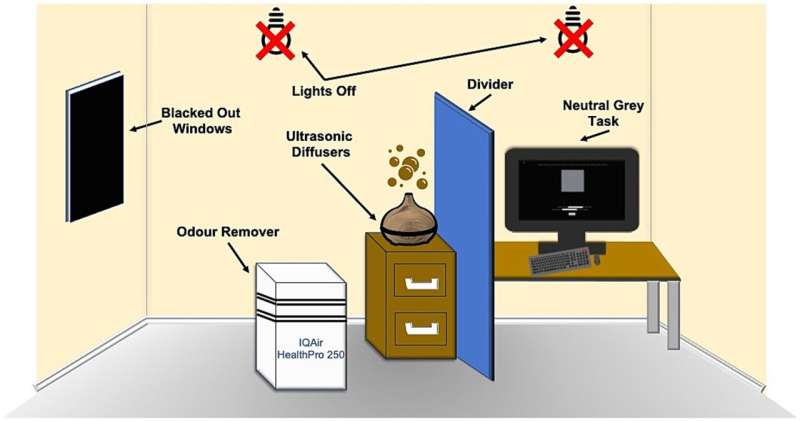Research reveals how smell can influence our perception of color

The University of Liverpool is part of a new study that reveals for the first time how particular scents can influence our perception of color.
In a paper, titled "Odors modulate color appearance," published in the journal Frontiers in Psychology, an interdisciplinary research team of University of Liverpool psychologists and engineers undertook an experiment to determine if smell does indeed influence how we perceive color.
The experiment involved 24 participants aged 20 to 57 sitting in front of a screen in an isolation room with blacked out windows, and no unwanted sensory stimuli or odors.
Then an ultrasonic diffuser released one of six scents—caramel, cherry, coffee, lemon, and peppermint, plus odorless water as a control—into the room. The scents were chosen as they induced the most robust odor-color associations in the team's prior work.
The participants were then asked to modify a square filled with a grayish color on a screen using two adjustable sliders—one yellow to blue and another one red to green—until they reached a color they judged as being devoid of any hue, that is, a perfect neutral gray color.
The results revealed that participants chose a more red-brown color gray when they smelt coffee, while opting for a yellow-brown version of the gray when the odor of caramel was pumped into the room.
The lead author of the paper is Dr. Ryan Ward, a senior lecturer at Liverpool John Moores University, who undertook the study when he was with the University of Liverpool's Department of Electrical Engineering and Electronics (EEE) and University of Liverpool's Digital Innovation Facility (DIF).
He said, "Here we show that the presence of different odors influences how humans perceive color. Our results showed that the perception of gray trended towards their anticipated correspondences for four out of five scents, namely lemon, caramel, cherry, and coffee."
The research is part of an unusual but exciting collaboration between Professor Alan Marshall, from the University's Department of EEE who heads up the Immersive Reality laboratory at the DIF, and Sophie Wuerger, Professor of Vision Science with the Department of Psychology.
They are working together to explore how olfactory information can be sent remotely and also how it influences our perception. Their longer-term research focus is the effective inclusion of olfactory information in Virtual Reality using their interdisciplinary expertise and the unique facilities in the Immersive Reality laboratory at the DIF.
Professor Wuerger said, "Research on the interactions between the sense of smell and vision is a fairly new area. The novelty of our experiment is that we used a robust tool to measure small perceived color changes and assess the perceived color in a more objective way which requires know-how of vision science. We believe we are the first team to do this."
Professor Alan Marshall said, "This is an exciting area of research which is important if we are to understand better how our senses influence our overall perception, which will also be a critical factor in designing the next generation of 'immersive reality' systems, such as the Metaverse, and has application not just in entertainment, but across a wide range of VR systems including the creative arts, training, education and health care."
More information: Ryan J. Ward et al, Odors modulate color appearance, Frontiers in Psychology (2023). DOI: 10.3389/fpsyg.2023.1175703
Journal information: Frontiers in Psychology
Provided by University of Liverpool Our sense of smell alters the colors we see, show scientists
No comments:
Post a Comment